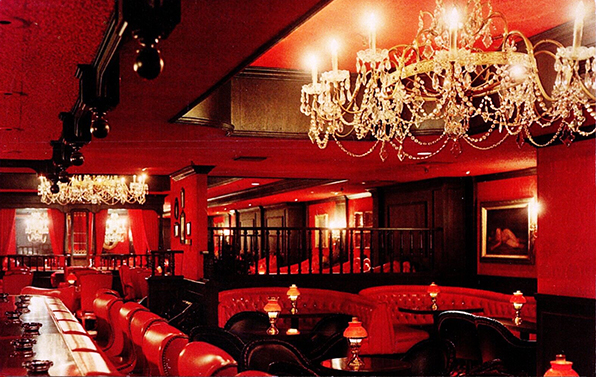The city of Oakland, California, was ready to be wowed in a big way when the MacArthur-Broadway Center opened its doors on September 9, 1965. In advance of the opening, full-page newspaper ads breathlessly hyped the “space-age” indoor mall as “a whole century ahead of its time…the most fantastic one-stop shopping and dining extravaganza in the entire universe!” It did, in fact, seem like something right out of The Jetsons, the prime-time cartoon sitcom that had debuted on the ABC television network three years earlier. A “Space Ramp” would take customers from the mall to a landing area where “Space Cadets” would help them with their bags and bundles onto an “Astro-Bus” that would take them to the 1,100-car “Space Port” rooftop parking lot on the roof.
The mall’s promoters also promised “a star-studded galaxy” of shops, services, and places to eat, including more than a dozen specialty cafes and such in “The Hamlet,” an early iteration of the food court. But the star dining attraction, opening on the same day as the shopping center, was Diamond Jim’s, the newest of 32 restaurants owned by Associated Hosts, Inc., the Beverly Hills-based restaurant chain that Joseph Bulasky had developed from Coffee Dan’s, his first Los Angeles venture in 1945.
Bulasky’s company reportedly spent $350,000 on the opulent interior of Diamond Jim’s, in keeping with the style of its namesake, Diamond Jim Brady (1856-1917), a millionaire businessman and financier known as much for his appetite as his wealth. Among his many other reported excesses, one story goes, Brady liked to mash a pound of caviar into his baked potatoes. George Rector, the proprietor of one of Brady’s favorite restaurants in New York City and later a famous food columnist and author, once called Brady “the best 25 customers I ever had.”
The Diamond Jim’s at 245 West MacArthur Boulevard in Oakland had all the Victorian trappings of the Gilded Age in which Brady lived: antique brass coach lamps, dark mahogany paneling, deep-red velour wallpaper, crystal chandeliers, leather banquettes, and, on the walls, ornately framed oil paintings of nude women. The restaurant’s cocktail lounge featured a piano bar and nightly entertainment.
Diamond Jim’s was chiefly a steak house, though, in addition to the charcoal-broiled steaks, dishes such as Veal Piccata and Spaghetti Caruso made regular appearances as featured entrées. An unusual touch came toward the end of each meal, when a basket of fresh fruit would be brought to the table along with a wedge of cheese and an assortment of crackers.
For whatever reason, the Diamond Jim’s in Oakland never really caught on. In 1971 Associated Hosts redecorated and rebranded it as the Ponderosa House of Prime Rib, with a menu limited to a full-bone cut of prime rib and four other entrées. But the Ponderosa concept, which had proved successful in the Los Angeles area, didn’t work out so well, either, and Associated Brands soon changed the restaurant back to Diamond Jim’s. In 1972, for what seemed like the blink of an eye, it became the Marquis. Then Maury Bleuel, the owner of the MacArthur-Broadway Center, formed a partnership with restaurateur Jerry Mancus, the owner of Mancuso’s restaurant in Pleasant Hill, to open a second Mancuso’s where Diamond Jim’s had been. But in keeping with the seeming curse on the location, Mancuso’s was put up for sale in 1972 and the following year became The Fox.
In later years the MacArthur-Broadway Center would become a rundown and somewhat scary shadow of its former self, and in 1997 Kaiser Permanente bought the nearly vacant mall with an eye toward converting into an outpatient and walk-in medical center. It demolished the shopping mall in 2009 to make way for a new hospital.
Famous Patrons of Diamond Jim’s
- Michael Caine
- Ronnie Schell

Veal Piccata
The Diamond Jim's restaurant in Oakland, California, opened in 1965 and closed in 1971. This preparation of Veal Piccata, adapted from the restaurant's original recipe, was a specialty of the house.
Ingredients
- 1 medium tomato
- 1 tablespoon Parmesan cheese
- 1 tablespoon unsalted butter
- 1/4 cup all-purpose flour
- Kosher salt, to taste
- Freshly ground black pepper, to taste
- 4 tablespoons high-heat vegetable oil (such as safflower, sunflower, peanut, or grapeseed), divided
- 1/2 pound (8 ounces) thinly sliced veal cutlets
- 1 medium-large zucchini
- 2 eggs, beaten
- 2 tablespoons drained capers, divided
Instructions
Heat oven to 375 degrees.
Cut a “V” out of the top of the tomato, fill with the Parmesan cheese, and top with the butter. Transfer to a baking sheet or dish and bake, uncovered, in the 375-degree oven for 10 to 15 minutes, or until done.
Combine the flour, salt, and pepper on a plate or in a shallow baking dish.
Prepare two large skillets, one for the veal and the other for the zucchini, by placing 2 tablespoons oil in each skillet and heating to medium-high temperature.
Dredge both sides of the veal slices in the seasoned flour, shaking off any excess flour. Sauté them one of the skillets until they are golden brown on both sides. in hot oil from 1 to 2 minutes on each side.
Trim the ends of the zucchini and slice lengthwise into 4 planks that are about 1/4-inch thick. Dip each plank into the beaten eggs, dredge in the seasoned flour, and sauté in the other skillet until they are golden brown on both sides.
Add 1 tablespoon capers to each skillet and heat through.
Arrange the veal, zucchini, and tomato attractively on a plate.
Notes
Although veal piccata is typically prepared and served in a lemon-and-butter sauce (sometimes with dry sherry or white wine), this recipe from Diamond Jim's is basically sauceless. Feel free, as always, to adjust to your liking.










No Comments